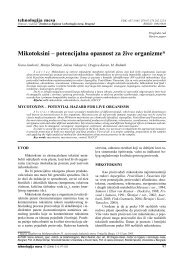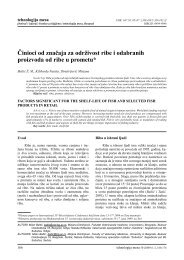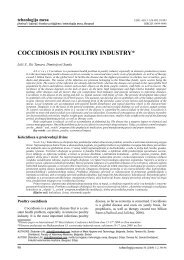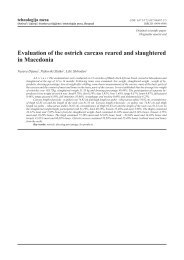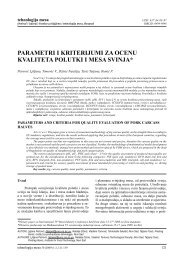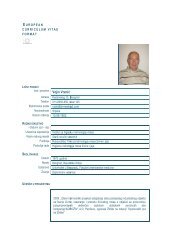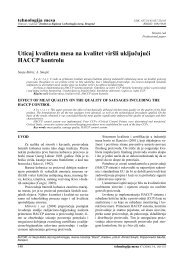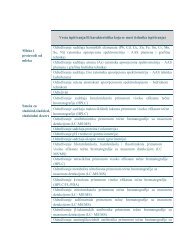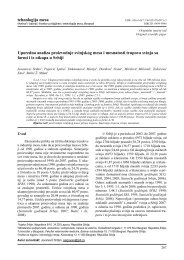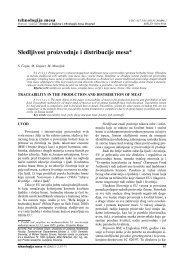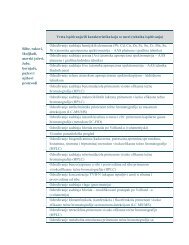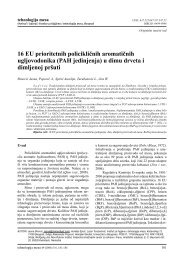Baltić Tatjana i dr. Uticaj vakuum pakovanja na mikrobiološki status i senzorska svojstva svežeg junećeg mesa ISO 15214, 1998. Microbiology of food and animal feeding stuffs– horizontal method for the enumeration of mesophilic lacticacid bacteria – Colony-count technique of 30°C. Lambropoulou K. A., Drosinos, E. H., Nychas G. J. E., 1996. The effect of glucose supplementationon the spoilage microflora and chemical <strong>com</strong>position of minced beefstored aerobically or under a modified atmosphere at 4°C. International Journal of Food Microbiology, 30, 281–291. Leistner L., 2000. Food protection by hurdle technology. International Journal of food Microbiology, 2, 2–26. Li M. Y., Zhou G. H., Xu X. L., Li C. B., Zhu W. Y., 2006. Changes of bacterial diversity and main florain chilled pork during storage using PCR-DGGE.Food Microbiology, 23, 607–611. Miller M. F., Kerth C.R., Wise J. W., Lansdell J. L., Stowell J. E., Ramsey C. B., 1997. Slaughter plant location, USDA quality grade, external fat tickness, and ageing time effects on sensory characteristics of beef loin strip steak. Journal of Animal Science, 75, 662–667. Monsón M., Sańudo C., Sierra I., 2005. Influence of breed and ageing time on the sensory meat quality and consumer acceptability in intensively reared beef. Meat Science 71, 471–479. Nortjé G. L., Shaw B. G., 1989. The effect of ageing treatment onthe microbiology and storage characteristics of beef in modifiedatmosphere packs containing 25% CO 2 plus 75% O2. MeatScience, 25, 43–58. Nychas G. J . E., Drosinos E., Board R. G., 1998. Chemical changes in stored meat. In:Board, R.G., Davies, A.R. (Eds.), The Microbiology of Meat and Poultry. Blackie. Nychas G. J. E., Skandamis P., 2005. Fresh meat spoilage and modified atmospherepackaging (MAP). In: Sofos, J.N. (Ed.), Improving the Safety of Fresh Meat. CRC/Woodhead Publishing Limited, Cambridge, 461–502. Nychas G. J. E., Skandamis P. N., Tassou C. C., Koutsoumanis K. P., 2008. Meat spoilage during distribution. Meat Science, 78, 77–89. Petäjä-Kanninen E., Puolanne E., 2007. Principles of Meat Fermentation. In: F. Toldrá (Ed.) Handbook of Fermented Meat and Poultry. BlackwellPublishing, 31–36. Pin C., Garcıa de Fernando G. D., Ordonez J. A., 2002. Effect of modified atmosphere<strong>com</strong>position on the metabolism of glucose by Brochothrix thermosphacta. Appliedand Environmental Microbiology, 68, 4441–4447. Prändl A., Fischer T., Schmidhofer H., Sinell J., 1988. Fleisch-Technologie und Hygienen der Gewinnung und Verarbeitung, Verlag Eugen Ulmer, Stuttgart. Robertson G. L., 2006. Food Packaging: Principles and Practice. CRC Press Tazlor and Francise, New Zealand. Russo F., Ercolini D., Mauriello G., Villani F.2006. Behaviour of Brochothrix thermosphacta inpresence of other meat spoilage microbial groups Food Microbiology, 23, 797–802. SRPS ISO 5496 2002. Iniciranje i obuka ocenjivača u otkrivanju i prepoznavanju mirisa, Senzorske analize. SRPS ISO 6658 2002. Kvantitativni deskriptivni test, Senzorske analize, Metodologija, Opšte uputstvo. SRPS ISO 3972 2002. Metoda utvrđivanja osećaja ukusa, Senzorske analize. SRPS EN ISO 11290, 2010. Mikrobiologija hrane i hrane za životinje – Horizontalna metoda za otkrivanje i određivanje <strong>broj</strong>a Listeria monocytogenes. SRPS EN ISO 4833, 2008. Mikrobiologija hrane i hrane za životinje – Horizontalna metoda za određivanje <strong>broj</strong>amikroorganizama – Tehnika <strong>broj</strong>anja kolonija na 30°C. SRPS EN ISO 6888-1, 2009. Mikrobiologija hrane i hrane za životinje – Horizontalna metoda za određivanje <strong>broj</strong>a koagulaza-pozitivnih stafilokoka (Staphylococcus aureus idruge vrste) – Deo 1: Tehnika upotrebom agara po Berd- Parkeru. SRPS ISO 16649-2, 2008. Mikrobiologija hrane i hrane za životinje – Horizontalna metoda za određivanje <strong>broj</strong>a β–glukuronidaza pozitivne Escherichia coli – Deo 2: Tehnika<strong>broj</strong>anja kolonija na 44°C pomoću 5-bromo-4-hloro-3indolil β-D– glukuronida. SRPS ISO 21528-2, 2009. Mikrobiologija hrane i hrane za životinje – Horizontalna metoda za otkrivanje iodređivanje <strong>broj</strong>a Enterobacteriaceae – Deo 2: Metoda<strong>broj</strong>anja kolonija. SRPS ISO 6579, 2008. Mikrobiologija hrane i hrane za životinje– Horizontalna metoda za otkrivanje Salmonella spp. SRPS ISO 15213, 2011. Mikrobiologija hrane i hrane za životinje – Horizontalna metoda za određivanje <strong>broj</strong>a sulfitoredukujučih bakterija koje rastu u anaerobnim uslovima. Sperber W. H., 2010. Introduction to the microbial spoilage of foods andbeverages. In: Sperber WH, Doyle MP, editors. Compendium of themicrobial spoilage of foods and beverages. Springer, N.Y., 1–40. Sun X. D., Holley R. A., 2012. Antimicrobial and Antioxidative Strategies to Reduce Pathogens and Extend the Shelf Life of Fresh Red Meats. Comprehensive Reviews in Food Science and Food Safety, Vol. 11, DOI: 10.1111/j. 1541–4337. 2012.00188.x. Šakota T., Lazić V., Gvozdenović J., 2002. Uticaj karakteristika ambalažnih materijala na održivost viršli. Tehnologija mesa, 43, 1–2, 47–51. Talon R., Leroy S., Fadda S., 2004. Dry fermented sausages. In: YH Hui, L Meunier-Goddik, ÅS Hansen, J Josephsen, W-K Nip, PS Stanfield, F Toldrá, eds. Handbook of Food and Beverage Fermentation Technology. New York: Marcel Dekker, Inc., 397–416. 110
Tehnologija mesa 53 (2012) 2, 103–111 The influence of vacuum packaging on microbiological status and sensory properties of fresh beef Baltić Tatjana, Borović Branka, Spirić Danka, Parunović Nenad, Karan Dragica, Mitrović Radmila, Radičević Tatjana S u m m a r y: The packaging method can signifi cantly affect the shelf life of fresh meat, and consequently the microbiological status and sensory properties of the packaged meat. In our country, for extending the shelf life of meat and meat products, the vacuum– packaging and packaging in the modified atmosphere are usually used. Vacuum– packaging favours the growth of facultative anaerobic bacteria, including lactic acid bacteria, Enterobacteriaceae and Brochothrix thermosphacta, as proven spoilage bacteria of fresh meat. Vacuum packaging has a positive infl uence on juiciness, tenderness, fl avor and ripening of meat, but it has negative infl uence on the meat color. The aim of the present study was to investigate the microbiological status and sensory properties of vacuum– packaged fresh beef. Samples of beef tenderlo in packaged in stretch foil and vacuum– packaged fresh beef tenderloin were kept in strictly controlled conditions, at 0-4°C. Microbiological and sensory examinations were performed on 1 st , 7 th , 14 th , 21 st and 28 th day of storage, in three separate cycles. Microbiological examinations included determination of microbial indicators of the processing hygiene and microbial indicators of meat spoilage (total count of aerobic mesophilic and psychrophilic bacteria, the number of Enterobacteriaceae, the number of lactic acid bacteria, the number of Brochothrix thermosphacta) and determination of pathogens (Salmonella spp., coagulasepositive staphylococci, sulphite-reducing bacteria, E. coli, Listeria monocytogenes) as wel l. Sensory properties were evaluated by using quantitative-descriptive test, on a scale of 1 to 5. The following properties were evaluated: appearance of meat, the color of meat surface, the color of the meat intersection, structure, texture, smell of the fresh meat, smell of meat after cooking, taste of meat after cooking and roasting. By sensory analyses spoilage of meat was established on 21 st day of investigation, in the fi rst cycle and on 28 th day, in the third cycle. Results obtained from microbiological examinations indicated meat spoilage on the same days, as well. In the second cycle of investigation the meat spoilage was established on 14 th day of storage, although the microbiological results did not indicate the meat spoilage. Key words: fresh beef, vacuum packaging, microbiological status, sensory evaluation. Rad primljen: 13.11.2012. Rad ispravljen: 16.11.2012. Rad prihvaćen: 21.11.2012. 111
- Page 1 and 2: ISSN 0494-9846 UDK 664.9:614.31: 63
- Page 3 and 4: OSNIVAČ I IZDAVAČ Institut za hig
- Page 5 and 6: tehnologija mesa Osnivač i izdava
- Page 7 and 8: Tabela 2. Nutritivna vrednost hrane
- Page 9 and 10: Tehnologija mesa 53 (2012) 2, 85-93
- Page 11 and 12: Tehnologija mesa 53 (2012) 2, 85-93
- Page 13 and 14: Tehnologija mesa 53 (2012) 2, 85-93
- Page 15 and 16: Tehnologija mesa 53 (2012) 2, 94-10
- Page 17 and 18: Organ ili sistem / Organ or system
- Page 19 and 20: Tehnologija mesa 53 (2012) 2, 94-10
- Page 21 and 22: Tehnologija mesa 53 (2012) 2, 94-10
- Page 23 and 24: tehnologija mesa Osnivač i izdava
- Page 25 and 26: Tehnologija mesa 53 (2012) 2, 103-1
- Page 27 and 28: Tehnologija mesa 53 (2012) 2, 103-1
- Page 29: Tehnologija mesa 53 (2012) 2, 103-1
- Page 33 and 34: Tehnologija mesa 53 (2012) 2, 112-1
- Page 35 and 36: Tehnologija mesa 53 (2012) 2, 112-1
- Page 37 and 38: Tehnologija mesa 53 (2012) 2, 112-1
- Page 39 and 40: Tehnologija mesa 53 (2012) 2, 112-1
- Page 41 and 42: tehnologija mesa Osnivač i izdava
- Page 43 and 44: Tehnologija mesa 53 (2012) 2, 121-1
- Page 45 and 46: Tehnologija mesa 53 (2012) 2, 121-1
- Page 47 and 48: tehnologija mesa Osnivač i izdava
- Page 49 and 50: Tehnologija mesa 53 (2012) 2, 127-1
- Page 51 and 52: Tehnologija mesa 53 (2012) 2, 127-1
- Page 53 and 54: Tehnologija mesa 53 (2012) 2, 127-1
- Page 55 and 56: Tehnologija mesa 53 (2012) 2, 134-1
- Page 57 and 58: Tabela 3. Prosečne vrednosti fizi
- Page 59 and 60: Tehnologija mesa 53 (2012) 2, 134-1
- Page 61 and 62: Tehnologija mesa 53 (2012) 2, 140-1
- Page 63 and 64: Vrsta / Species Tehnologija mesa 53
- Page 65 and 66: Tehnologija mesa 53 (2012) 2, 140-1
- Page 67 and 68: Tehnologija mesa 53 (2012) 2, 140-1
- Page 69 and 70: Tehnologija mesa 53 (2012) 2, 148-1
- Page 71 and 72: Tehnologija mesa 53 (2012) 2, 148-1
- Page 73 and 74: Tehnologija mesa 53 (2012) 2, 148-1
- Page 75 and 76: Tehnologija mesa 53 (2012) 2, 148-1
- Page 77 and 78: tehnologija mesa Osnivač i izdava
- Page 79 and 80: Tehnologija mesa 53 (2012) 2, 157-1
- Page 81 and 82:
Tehnologija mesa 53 (2012) 2, 157-1
- Page 83 and 84:
Tehnologija mesa 53 (2012) 2, 157-1
- Page 85 and 86:
Tehnologija mesa 53 (2012) 2, 157-1
- Page 87 and 88:
Tehnologija mesa 53 (2012) 2, 166-1
- Page 89 and 90:
Tehnologija mesa 53 (2012) 2, 166-1
- Page 91 and 92:
Tehnologija mesa 53 (2012) 2, 166-1
- Page 93 and 94:
tehnologija mesa Osnivač i izdava
- Page 95 and 96:
Tehnologija mesa 53 (2012) 2, 173-1
- Page 97 and 98:
Tehnologija mesa 53 (2012) 2, 173-1
- Page 99 and 100:
Tehnologija mesa 53 (2012) 2, 179 U
- Page 101 and 102:
GUIDELINES FOR THE AUTHORS Tehnolog
- Page 103:
CIP - Каталогизација



